A bushy cell network in the rat ventral cochlear nucleus
- PMID: 19634178
- PMCID: PMC2841288
- DOI: 10.1002/cne.22139
A bushy cell network in the rat ventral cochlear nucleus
Abstract
Geometry of the dendritic tree and synaptic organization of afferent inputs are essential factors in determining how synaptic input is integrated by neurons. This information remains elusive for one of the first brainstem neurons involved in processing of the primary auditory signal from the ear, the bushy cells (BCs) of the ventral cochlear nucleus (VCN). Here, we labeled the BC dendritic trees with retrograde tracing techniques to analyze their geometry and synaptic organization after immunofluorescence for excitatory and inhibitory synaptic markers, electron microscopy, morphometry, double tract-tracing methods, and 3D reconstructions. Our study revealed that BC dendrites provide space for a large number of compartmentalized excitatory and inhibitory synaptic interactions. The dendritic inputs on BCs are of cochlear and noncochlear origin, and their proportion and distribution are dependent on the branching pattern and orientation of the dendritic tree in the VCN. Three-dimensional reconstructions showed that BC dendrites branch and cluster with those of other BCs in the core of the VCN. Within the cluster, incoming synaptic inputs establish divergent multiple-contact synapses (dyads and triads) between BCs. Furthermore, neuron-neuron connections including puncta adherentia, sarcoplasmic junctions, and gap junctions are common between BCs, which suggests that these neurons are electrically coupled. Overall, our study demonstrates the existence of a BC network in the rat VCN. This network may establish the neuroanatomical basis for acoustic information processing by individual BCs as well as for enhanced synchronization of the output signal of the VCN.
Figures
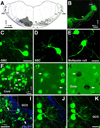
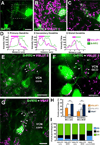
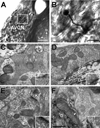


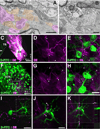


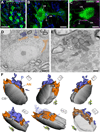


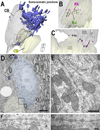
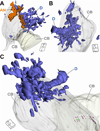

Similar articles
-
Ultrastructure, synaptic organization, and molecular components of bushy cell networks in the anteroventral cochlear nucleus of the rhesus monkey.Neuroscience. 2011 Apr 14;179:188-207. doi: 10.1016/j.neuroscience.2011.01.058. Epub 2011 Feb 1. Neuroscience. 2011. PMID: 21284951 Free PMC article.
-
Salicylate-Induced Hearing Loss Trigger Structural Synaptic Modifications in the Ventral Cochlear Nucleus of Rats via Medial Olivocochlear (MOC) Feedback Circuit.Neurochem Res. 2016 Jun;41(6):1343-53. doi: 10.1007/s11064-016-1836-x. Epub 2016 Feb 17. Neurochem Res. 2016. PMID: 26886762
-
Cochlear nucleus neurons redistribute synaptic AMPA and glycine receptors in response to monaural conductive hearing loss.Neuroscience. 2009 Nov 10;163(4):1264-76. doi: 10.1016/j.neuroscience.2009.07.049. Epub 2009 Jul 28. Neuroscience. 2009. PMID: 19646510 Free PMC article.
-
The multiple functions of T stellate/multipolar/chopper cells in the ventral cochlear nucleus.Hear Res. 2011 Jun;276(1-2):61-9. doi: 10.1016/j.heares.2010.10.018. Epub 2010 Nov 4. Hear Res. 2011. PMID: 21056098 Free PMC article. Review.
-
Modulatory influences on time-coding neurons in the ventral cochlear nucleus.Hear Res. 2019 Dec;384:107824. doi: 10.1016/j.heares.2019.107824. Epub 2019 Oct 17. Hear Res. 2019. PMID: 31670183 Review.
Cited by
-
Central Compensation in Auditory Brainstem after Damaging Noise Exposure.eNeuro. 2018 Aug 17;5(4):ENEURO.0250-18.2018. doi: 10.1523/ENEURO.0250-18.2018. eCollection 2018 Jul-Aug. eNeuro. 2018. PMID: 30123822 Free PMC article.
-
Origin and function of short-latency inputs to the neural substrates underlying the acoustic startle reflex.Front Neurosci. 2014 Jul 25;8:216. doi: 10.3389/fnins.2014.00216. eCollection 2014. Front Neurosci. 2014. PMID: 25120419 Free PMC article.
-
Connexin36 RNA Expression in the Cochlear Nucleus of the Echolocating Bat, Eptesicus fuscus.J Assoc Res Otolaryngol. 2023 Jun;24(3):281-290. doi: 10.1007/s10162-023-00898-y. Epub 2023 May 30. J Assoc Res Otolaryngol. 2023. PMID: 37253961 Free PMC article.
-
The number and distribution of AMPA receptor channels containing fast kinetic GluA3 and GluA4 subunits at auditory nerve synapses depend on the target cells.Brain Struct Funct. 2017 Nov;222(8):3375-3393. doi: 10.1007/s00429-017-1408-0. Epub 2017 Apr 10. Brain Struct Funct. 2017. PMID: 28397107 Free PMC article.
-
Female GluA3-KO mice show early onset hearing loss and afferent swellings in ambient sound levels.bioRxiv [Preprint]. 2024 Apr 15:2024.02.21.581467. doi: 10.1101/2024.02.21.581467. bioRxiv. 2024. Update in: iScience. 2025 Jan 13;28(2):111799. doi: 10.1016/j.isci.2025.111799. PMID: 38659964 Free PMC article. Updated. Preprint.
References
-
- Agmon-Snir H, Carr CE, Rinzel J. The role of dendrites in auditory coincidence detection. Nature. 1998;393(6682):268–272. - PubMed
-
- Altschuler RA, Betz H, Parakkal MH, Reeks KA, Wenthold RJ. Identification of glycinergic synapses in the cochlear nucleus through immunocytochemical localization of the postsynaptic receptor. Brain Res. 1986;369(1–2):316–320. - PubMed
-
- Benson TE, Berglund AM, Brown MC. Synaptic input to cochlear nucleus dendrites that receive medial olivocochlear synapses. J Comp Neurol. 1996;365(1):27–41. - PubMed
-
- Brawer JR, Morest DK. Relations between auditory nerve endings and cell types in the cat's anteroventral cochlear nucleus seen with the Golgi method and Nomarski optics. J Comp Neurol. 1975;160(4):491–506. - PubMed
Publication types
MeSH terms
Grants and funding
LinkOut - more resources
Full Text Sources
Miscellaneous

